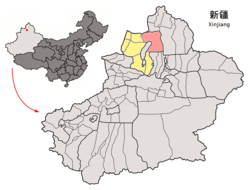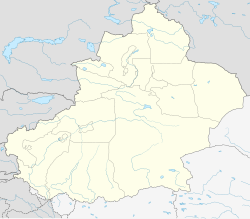Hoboksar Mongol Autonomous County
|
Hoboksar County 和布克赛尔县 • قوبىقسارى اۋدانى • قوبۇقسار ناھىيىسى (Chinese) • (Uyghur) • (Kazakh) ᠬᠣᠪᠣᠭᠰᠠᠶᠢᠷ ᠰᠢᠶᠠᠨ (Mongolian) |
|
|---|---|
| Autonomous county | |
|
Hoboksar Mongol Autonomous County
ᠬᠣᠪᠣᠭᠰᠠᠶᠢᠷ ᠮᠣᠩᠭᠣᠯ ᠥᠪᠡᠷᠲᠡᠭᠡᠨ ᠵᠠᠰᠠᠬᠤ ᠰᠢᠶᠠᠨ
和布克赛尔蒙古自治县 قوبۇقسار موڭغۇل ئاپتونوم ناھىيىسى قوبىقسارى موڭعۇل اۆتونوميالى اۋدانى |
|
 Location of the county |
|
| Location in Xinjiang | |
| Coordinates: 46°47′N 85°43′E / 46.783°N 85.717°ECoordinates: 46°47′N 85°43′E / 46.783°N 85.717°E | |
| Country | People's Republic of China |
| Region | Xinjiang |
| Prefecture | Tacheng |
| Township-level divisions | 2 towns 5 townships |
| County seat | Hoboksar Town (和布克赛尔镇) |
| Area | |
| • Total | 28,799 km2 (11,119 sq mi) |
| Population | |
| • Total | 50,000 |
| • Density | 1.7/km2 (4.5/sq mi) |
| Time zone | China Standard (UTC+8) |
| Postal code | 834400 |
| Area code(s) | 0901 |
| Hoboksar Mongol Autonomous County | |||||||||
| Chinese name | |||||||||
|---|---|---|---|---|---|---|---|---|---|
| Simplified Chinese | 和布克赛尔蒙古自治县 | ||||||||
| Traditional Chinese | 和布克賽爾蒙古自治縣 | ||||||||
|
|||||||||
| Mongolian name | |||||||||
| Mongolian Cyrillic | Ховогсайр | ||||||||
| Mongolian script | ᠬᠣᠪᠣᠭᠰᠠᠶᠢᠷ ᠮᠣᠩᠭᠣᠯ ᠥᠪᠡᠷᠲᠡᠭᠡᠨ ᠵᠠᠰᠠᠬᠤ ᠰᠢᠶᠠᠨ | ||||||||
|
|||||||||
| Uyghur name | |||||||||
| Uyghur |
قوبۇقسار
|
||||||||
|
|||||||||
| Kazakh name | |||||||||
| Kazakh |
قوبىقسارى موڭعۇل اۆتونوميالى اۋدانى Qobıqsarı Moñğul avtonomyalı awdanı Қобықсары Моңғұл автономйалы ауданы |
||||||||
| Transcriptions | |
|---|---|
| Standard Mandarin | |
| Hanyu Pinyin | Hébùkèsài'ěr Měnggǔ Zìzhìxiàn |
| Wade–Giles | He4-pu4-k'e4-sai4-erh3 Meng3-ku3 Tzu4-chih4-hsien4 |
| Transcriptions | |
|---|---|
| SASM/GNC | Qoboγsayir mongγol öbertegen ǰasaqu siyan |
| Transcriptions | |
|---|---|
| Latin Yëziqi | Qobuqsar |
| Yengi Yeziⱪ | Ⱪobuⱪsar |
| Siril Yëziqi | Қобуқсар |
Hoboksar Mongol Autonomous County is a county situated in the Xinjiang Uyghur Autonomous Region and is under the administrative jurisdiction of the Tacheng Prefecture. It has an area of 28,799 km² with a population of 50,000. The Postcode is 834400.
Hoboksar County is located south of the Tarbagatai-Saur mountain range, and its northern part, where most of the county's population lives, receives some water from streams (such as the Baiyang River) flowing from the snow-capped mountains. The southeastern part of the county is in Gurbantünggüt Desert.
Historically, the large Alan Nur and Manas Lake were located in the desert southwestern part of the county; they received water, at least intermittently, both from the streams flowing across the desert from the north and from the south (via the Manas River). Due to the increasing water diversion for irrigation and other human needs, as well as geological processes, the Alan Nur has fully dried out, and the Manas Lake is in a fairly precarious situation as well.
The Irtysh–Karamay Canal, constructed around the turn of the 21st century, crosses the county's southeastern part; the canal's Fengcheng Reservoir is located on the county's border with Karamay City's Urho District.
A point situated some 30 miles ESE of Hoxtolgay Town is listed as the farthest point from the sea (at 46°16.8′N 86°40.2′E / 46.2800°N 86.6700°E) by the Guinness Book of World Records. It is roughly 2646 kilometres away from the Arctic Ocean and a similar distance from the Bay of Bengal and the Arabian Sea (see Continental Pole of Inaccessibility for other candidates).
...
Wikipedia

